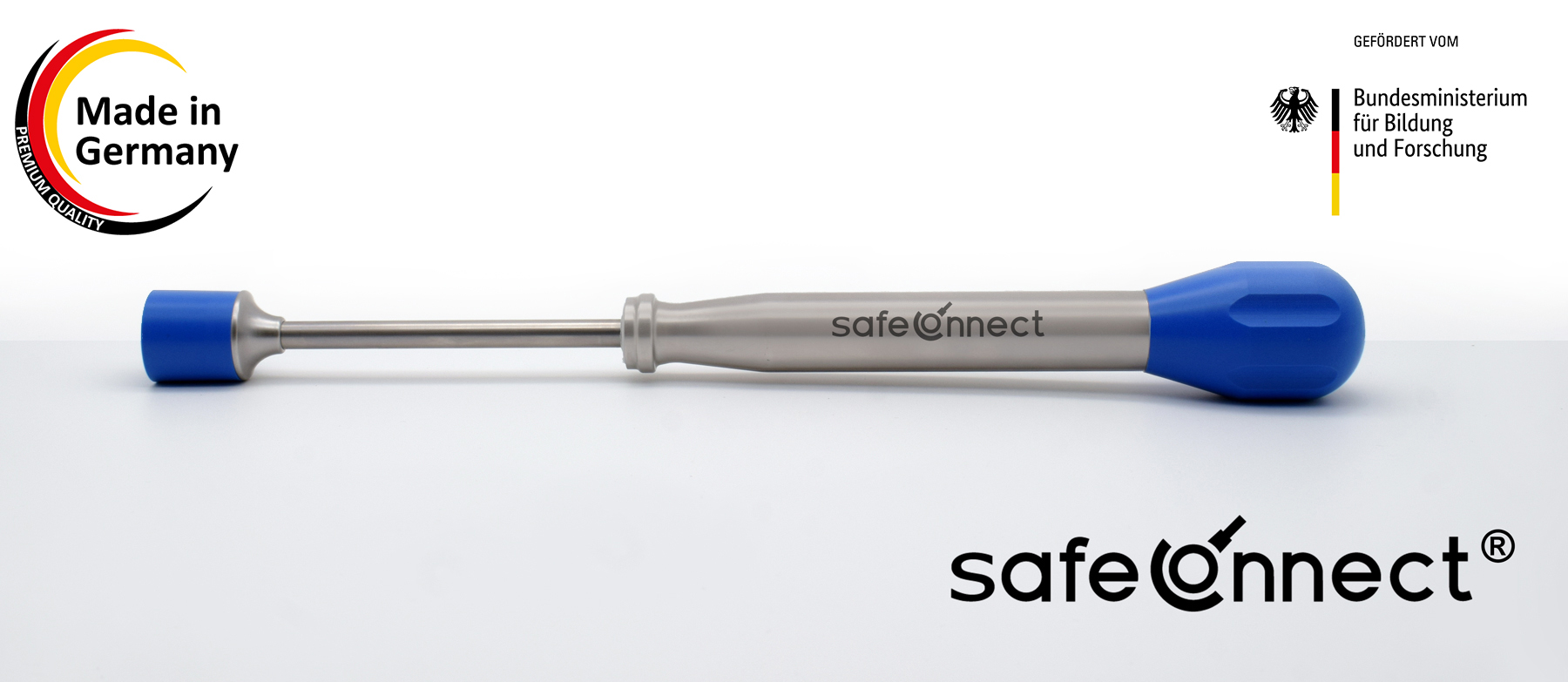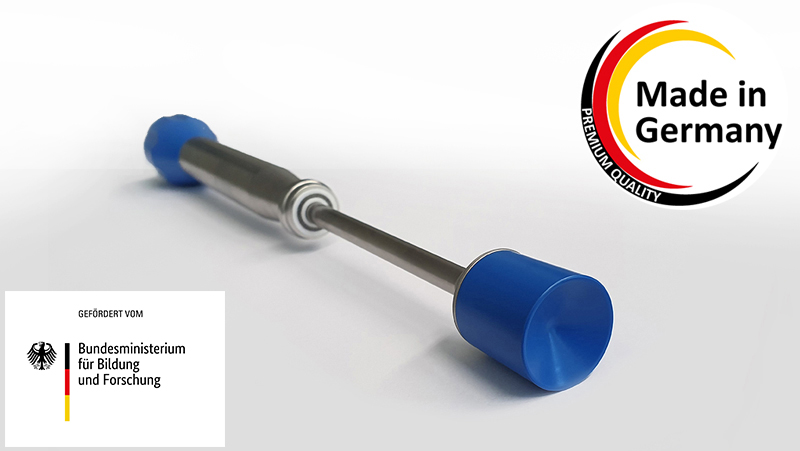safeConnect®

El rango de fuerza de impacto durante la conexión manual de la cabeza femoral es extremadamente alto y por lo tanto representa un riesgo. Los estudios científicos muestran que una fuerza de impacto constante tiene una gran influencia en la seguridad de la conexión cónica.
Bajo evaluación científica, se desarrolló un método de prueba de impacto estandarizado, que asegura una unión reproducible de la conexión cónica con una introducción óptima de la fuerza, reemplazando así el implante manual de la cabeza femoral / inserto con un martillo.
safeConnect es, por lo tanto, el instrumento indispensable para la artroplastia primaria y de revisión.

Principio de funcionamiento:
El instrumento es ajustado positivamente en la cabeza femoral / inserto y presionado de una sola vez en la dirección axial de la prótesis. Una fuerza de unión precisa y constante se dispara impulsivamente e impacta la conexión cónica.
Resumen de las ventajas:
- Procedimiento estandarizado y seguro
- Transmisión de fuerza precisa y reproducible
- Un instrumento para todas las cabezas femorales e insertos
- Manejo quirúrgico simple, fácil de usar.
- Instrumento reutilizable
safeConnect - la innovación para la artroplastia de cadera
Cómo funciona safeConnect
Para los subtítulos en español, activa los subtítulos de vídeo en el menú de la parte inferior.
Puedes elegir el idioma en el menú situado junto a "ajustes".

| Articulos y Recambios | |||||
| Pos. | Ref. Nr. | Nombre | Pos. | Ref. Nr. | Nombre |
| 1 | 740100 | Instrumento safeConnect | 2 | 740120 | Aditamento de cabeza esférica safeConnect |
Literatura sobre este tema
[1] LEARMONTH, I.D., YOUNG, C., RORABECK, C. (2007).
The operation of the century: total hip replacement. Lancet. 370 (9597): S. 1508-19.
[2] KAUFMANN-KOLLE, P., WILLMS, G. (Göttingen 2011).
Qualitätsreport 2010. Gemeinsamer Bundesausschuss Berlin. AQUA – Institut für angewandte Qualitätsförderung und Forschung im Gesundheitswesen GmbH.
[3] KURTZ, S., ONG, K., LAU, E., MOWAT, F., HALPERN, M. (2007).
Projections of primary and revision hip and knee arthroplasty in the United States from 2005 to 2030. J Bone Joint Surg Am. 89 (4): S. 780-5.
[4] BISHOP, N., WITT, F., POURZAL, R., FISCHER, A., RUTSCHI, M., MICHEL, M., MORLOCK, M. (2013).
Wear patterns of taper connections in retrieved large diameter metal-on-metal bearings. J Orthop Res. 31 (7): S. 1116-22.
[5] LANGTON, D.J., SIDAGINAMALE, R., LORD, J.K., NARGOL, A.V.F., JOYCE, T.J. (2012).
Taper junction failure in large-diameter metal-on-metal bearings. Bone and Joint Research. 1 (4): S. 56-63.
[6] KOCAGOZ, S.B., UNDERWOOD, R.J., SIVAN, S., GILBERT, J.L., MACDONALD, D.W., DAY, J.S., KURTZ, S.M. (2013).
Does Taper Angle Clearance Influence Fretting and Corrosion Damage at the Head-Stem Interface? A Matched
Cohort Retrieval Study. Seminars in arthroplasty. 24 (4): S. 246-254.
[7] LAKSTEIN, D., KOSASHVILI, Y., BACKSTEIN, D., SAFIR, O., LEE, P., GROSS, A.E. (2010).
Revision total hip arthroplasty with a modular tapered stem. Hip Int. 20 (2): S. 136-42.
[8] MCMASTER, W.C., PATEL, J. (2013).
Adverse local tissue response lesion of the knee associated with Morse taper corrosion. J Arthroplasty. 28 (2): S. 375.e5-8.
[9] MEYER, H., MUELLER, T., GOLDAU, G., CHAMAON, K., RUETSCHI, M., LOHMANN, C.H. (2012).
Corrosion at the cone/taper interface leads to failure of large-diameter metal-on-metal total hip arthroplasties. Clin Orthop Relat Res. 470 (11): S. 3101-8.
[10] LAVERNIA, C.J., BAERGA, L., BARRACK, R.L., TOZAKOGLOU, E., COOK, S.D., LATA, L., ROSSI, M.D. (2009).
The effects of blood and fat on Morse taper disassembly forces. Am J Orthop (Belle Mead NJ). 38 (4): S. 187-90.
[11] REHMER, A., BISHOP, N.E., MORLOCK, M.M. (2012).
Influence of assembly procedure and material combination on the strength of the taper connection at the head-neck junction of modular hip endoprostheses. Clinical biomechanics (Bristol, Avon). 27 (1): S. 77-83.
[12] NASSUTT, R., MOLLENHAUER, I., KLINGBEIL, K., HENNING, O., GRUNDEI, H. (2006).
[Relevance of the insertion force for the taper lock reliability of a hip stem and a ceramic femoral head]. Biomed Tech (Berl). 51 (2): S. 103-9.
[13] COOK, S.D., MANLEY, M.T., KESTER, M.A., DONG, N.G. (1993).
Torsional resistance and wear of a modular sleeve-stem hip system. Clinical materials. 12 (3): S. 153-8.
[14] MUNIR, S., WALTER, W.L., WALSH, W.R. (2015).
Variations in the trunnion surface topography between different commercially available hip replacement stems. J Orthop Res. 33 (1): S. 98-105.
[15] GILBERT, J.L., BUCKLEY, C.A., JACOBS, J.J. (1993).
In vivo corrosion of modular hip prosthesis components in mixed and similar metal combinations. The effect of crevice, stress, motion, and alloy coupling. J Biomed Mater Res. 27 (12): S. 1533-44.
[16] KRETZER, J.P., JAKUBOWITZ, E., KRACHLER, M., THOMSEN, M., HEISEL, C. (2009).
Metal release and corrosion effects of modular neck total hip arthroplasty. Int Orthop. 33 (6): S. 1531-6.
[17] GOLDBERG, J.R., GILBERT, J.L. (2003).
In vitro corrosion testing of modular hip tapers. J Biomed Mater Res B Appl Biomater. 64 (2): S. 78-93.
[18] KHAN, M.A., WILLIAMS, R.L., WILLIAMS, D.F. (1999).
The corrosion behaviour of Ti-6Al-4V, Ti-6Al-7Nb and Ti-13Nb-13Zr in protein solutions. Biomaterials. 20 (7): S. 631-7.
[19] GRUPP, T.M., WEIK, T., BLOEMER, W., KNAEBEL, H.P. (2010).
Modular titanium alloy neck adapter failures in hip replacement--failure mode analysis and influence of implant material. BMC Musculoskelet Disord. 11: S. 3.
[20] GOLDBERG, J.R., GILBERT, J.L., JACOBS, J.J., BAUER, T.W., PAPROSKY, W., LEURGANS, S. (2002).
A multicenter retrieval study of the taper interfaces of modular hip prostheses. Clin Orthop Relat Res. 401: S. 149-61.




